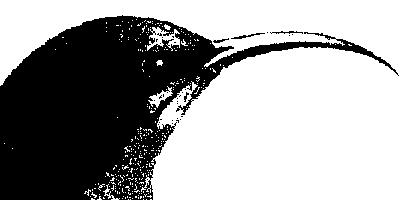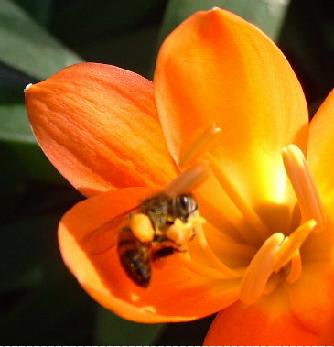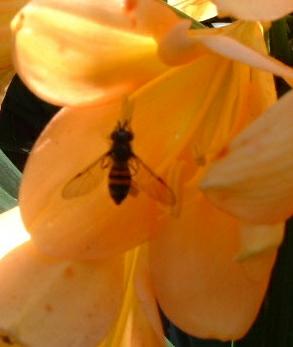
CliviaNet___________
for clivia lovers around the World
| CliviaNet Home |
| Clivia Overview |
| Cultivation |
| E-Mail and Chat |
| Clivia Society |
| Photo Gallery |
| Seed Exchange |
| Sources |
| Links |
| People |
In the wild, the Clivia species caulescens, gardenii, nobilis, and probably mirabilis are characterized by flowers that attract sunbirds: tubular, pendant, and with red coloration. Similar but unrelated species also pollinated by sunbirds include Aloe and Kniphofia.

Sunbirds are small birds with long, curving beaks that can reach the nectaries at the base of tubular flowers. Sunbirds like to hang upside down from the flower stalk and sip the nectar from below the flower. Val Thursten on the KwaZulu (KZN), South Africa, coast has reported sunbirds at gardenii, where the beak and flower shapes of the pendant species give a good evolutionary match.

| 
|
| Bee in Clivia miniata flower | Hover fly at Clivia miniata flower |
Clivia miniata has a quite different flower form and coloration. With flared and semi-erect to erect orange flowers, miniata is a typical insect pollinated plant species. Likely pollinators include bees and flies, especially hover flies.
After the '02 Clivia Conference, in Emmie Wittig's garden in the KZN midlands, we saw bees and hoverflies very active around miniata (photos), although the former appeared to be more interested in packing pollen (just look at that hind leg!) than collecting nectar.
Dave Conway observed in California that there is one other possible pollinator, very young (ity bity just hatched) snails. They love pollen and will clean an umbel overnight, so a logical conclusion would be that berries that matured on a scape after the pollen was eaten were probably pollinated by a snail that went up the stigma looking for pollen after he had already been up a few other anthers and carried their pollen to the stigma.
Clivia pollen is quite light and fluffy. Some natural pollination very likely is the result of the wind or of animals merely brushing past Clivias in flower.
The berries on Clivia plants are reddish in color when ripe. Red typically is a color that attracts birds. There are also suggestions that monkeys, baboons, and rodents may eat the flesh of the berry. They leave the seeds themselves intact and nicely cleaned.
Another interesting story told by Connie and James Abel is that in the mid '90s a senior committee member was horrified to discover that a large umbel from a prized yellow plant was suddenly stripped of seed. He was convinced of the guilt of a neighbour, but could do nothing in the absence of any evidence. That was fortunate - about 14 days later he discovered all his seed, cleaned and neatly piled under leaves a few feet away.
Many natural habitats of Clivia are on sloping ground, and the patterns of occurrence of the plants in wild colonies suggest that gravity is a signifcant mechanism for dispersal of Clivia seeds. Seeds can fall to the ground from over-ripe, rotting berries. Rainfall can help by washing loose berries along the direction of run-off.
Pictures and stories kindly contributed by Connie and James Able, and reproduced with permission.
David Conway sent the following form California:
Add to your list of birds that disperse/plant Clivia seeds the USA's Scrub Jay. It may not be that Clivias are endemic to California, but Clivias do naturalize in southern California or at least in Santa Barbara. We have our March winds that pollinate the flowers, we will leave wind pollinated berries on for those that are coming on the 21st of March, the roof rats that clean the berries, leaving perfectly clean seeds and the Blue Jays that will disperse/plant each seed. Mother Nature's system isn't without fault by our standards: each wind pollinated seed must be considered selfed and it may not be; the rats will generally pick a berry and take to one location between containers where you will find cleaned seeds by the hundreds but you don't know which plant they came from and the the Scrub Jay doesn't plant them where we might like. It may plant them in another container or a few blocks away in some other garden or hillside. The one thing you learn quickly is to not leave just cleaned seeds outside to dry in the sun or you will find the count can go down rapidly because of this avian bandit.
For tips on doing your own pollinations, see: ![]()